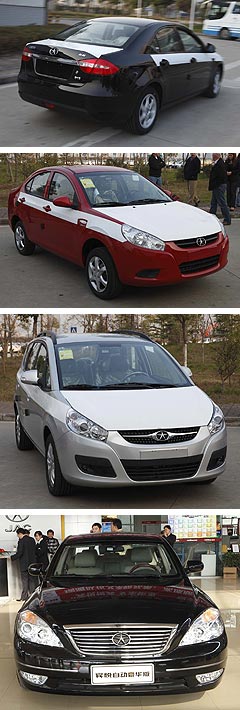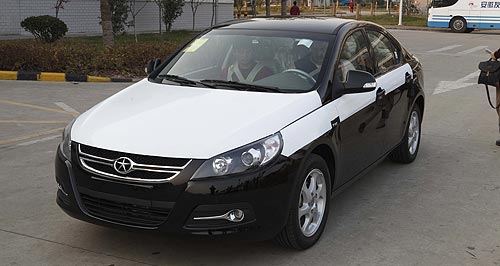Future models - JAC - B-ClassChina's JAC shows off car range as it mulls Oz invasionThat's a wrap: GoAuto took the opportunity of a three-minute lap around a factory complex in a freshly minted JAC B-Class still wrapped in its protective plastic. Italian-styled small car shows the way for Chinese car-maker JAC as it looks west18 Nov 2010 By RON HAMMERTON in SHANGHAI A PININFARINA-designed small car with European engineering input is a pointer to what Australian motorists can expect when Chinese car-maker JAC (Jianghai Automobile Company) expands its global export assault from trucks to passenger cars over the next few years. The Corolla-sized 1.5-litre JAC B-Class is the freshest offering in JAC's eight-model passenger car range that didn't exist just eight years ago, but which JAC is expanding by a staggering two to three models a year. The Chinese car-maker is looking to take on the likes of Toyota, General Motors and Volkswagen with this rapidly expanding range that, on the Chinese domestic market, already includes mini, light, small and medium sedans and hatchbacks, as well as a compact SUV, people-mover, one-tonne pick-up and a huge truck range. The latter is set to pioneer the brand in Australia from the second quarter of next year through importer White Motor Company and a 20-plus dealer network.  From top: JAC B-Class, JAC, A-Class, JAC B-Cross, JAC C-Class. From top: JAC B-Class, JAC, A-Class, JAC B-Cross, JAC C-Class.JAC has even established research and development centres in Turin, Italy, and Tokyo, Japan, to draw on the best ideas and talent in its breakneck quest to become a world automotive player by 2015. A state-of-the-art engine plant and world-class passenger car assembly factory at Hefei, in central China, are turning out JAC-branded cars for the domestic Chinese market where JAC is a well established truck and bus brand and a rapidly growing car name. This year, JAC total vehicle production is up 40 per cent, on the way to 470,000 units this year, with only 22,000 – mostly trucks – destined for export markets. It plans to push this export volume to 300,000 in just five years, with at least 90,000 of that being passenger cars. So far, most of JAC's light vehicles are clearly inspired by a grab-bag of existing models from global manufacturers, including Mercedes-Benz, Honda, Hyundai and Chevrolet. The most unique model is the new JAC B-Class sedan, which JAC says was a co-operative job with the famous Italian design house Pininfarina. The crossover hatch B-Cross version, however, still exhibits an element of cloning, looking like a Honda Jazz from the rear. Nevertheless, it illustrates the Chinese push away from clones and own home-grown awkward designs to internationally acceptable styling that will allow the burgeoning industry – now the world's biggest with a projected 17 million sales this year – to compete on more equal terms with the global big boys in the west. Powered by JAC's own 1.5-litre four-cylinder engine in 76kW and variable valve timing 83kW versions, the B-Class – also known as the Tojoy in China – is badged 'B15'. Torque for the two Euro 4 compliant engine variants is rated at 130Nm at 4500rpm for the base engine and 146Nm at 4000rpm for the VVT powerplant that is optional on the top-end Luxury model. No fuel economy figures were quoted for this model. Sitting on a 2710mm wheelbase, the 4590mm long sedan seats five and weighs in at 1315kg. Suspension is MacPherson strut on the front and what appears from drawings to be multi-link on the rear. A single driver's airbag is fitted on the base Comfort model, while the Elegant and Luxury versions get a passenger airbag as well. There is no sign of side or curtain airbags, and while ABS is standard, ESC is missing – an oversight that would need to be addressed for western markets. Standard equipment includes power windows, an anti-theft system and halogen headlights, while rear parking sensors and leather trim are standard on the Luxury version. A taller, crossover version of the B-Class, the B-Cross, seats up to seven and gets a bigger, 1.8-litre engine with 105kw of power and 165Nm of torque. Another JAC model that would seem to be a walk-up start for Australia is the smaller, light-sized A-Class, which is offered with a choice of two 1.3-litre four-cylinder engines – a base 69kW-at-6000rpm engine and a variable valve timing 73kW version for up-spec models. Torque is 114Nm and 126Nm respectively. Like the B-Class, the A-Class is offered in both hatch and sedan guises, both sitting on a 2400mm wheelbase, with overall length of the sedan coming in at 4155mm and the hatch at 3965mm. Five-speed manual and automatic transmissions are available, and fuel economy is said to be a commendable 4.9 litres per 100km. The Hyundai-like compact SUV, the SRV – known in China as the Rein – comes with either a 2.0-litre 95kW/175Nm engine, a bigger 2.4-litre 100kW/193Nm version or a turbo-charged 2.0-litre petrol performance leader banging out 120kW/235Nm. The 2.0- and 2.4-litre petrol engines also power JAC's biggest sedan, the Camry-sized C-Class that uses Mercedes-Benz's models as, ahem, inspiration. Along with the hugely popular MPV – China's best-selling people-mover for a number of years after it led JAC into the passenger vehicle realm in 2002 – the C-Class is among the older models, and will clearly be in for a makeover before any overseas launch can be contemplated. Likewise, the JAC one-tonne Pick-up is getting some treatment soon, including the addition of a 4x4 model. The Pick-up gets the option of diesel, in a 2.0-litre format of JAC's own making. Like most of JAC's products, this engine uses off-the-shelf technology from best-practice suppliers such as Bosch. This month, JAC launches its newest model, the A0-Class mini hatch, whose styling gives more than a nod to the Toyota Aygo available in Japan. JAC says it will be powered by a 1.0-litre engine, but other details were scant at the media briefing at JAC's headquarters in Hefei, 600km west of Shanghai. Clearly, JAC is ticking all the boxes in its model range, benchmarking against what it considers to be the best. Right now, it is honing its systems in the Chinese domestic market and developing countries in Asia, Africa and South America, while buying in some expert help to speed the development process. Although JAC passenger car import arrangements for Australia remain up in the air, it seems just a matter of time before the Chinese giant launches a wave of its newest models Down Under – a wave that might just become unstoppable. Drive impressions: IF a three-minute lap around a factory complex in a freshly minted car still wrapped in its protective plastic – even the steering wheel – constitutes a test drive, then this is it. GoAuto managed this tiny taste of JAC's newest offering, the B-Class small car launched this year, that is set to take on the world's biggest sellers, the Toyota Corolla and Volkswagen Golf. Clearly, Toyota and VW have nothing to worry about from technology, performance or dynamics points of view. But it is the potential of this little car and its eight stablemates, backed by the Chinese powerhouse that is JAC, that must give executives in Nagoya and Wolfsburg some sleepless nights. A visit to a JAC car showroom in the company home town of Hefei, central China, shows it has a long way to go on quality. Uneven panels gaps, shiny hard plastics and – on an SRV SUV – a rubber window strip carelessly sticking up above the door frame in a fashion that would give Australian buyers the vapours, demonstrate the tough road ahead. By as China's Confucius said, every journey of 1000 miles starts with a single step. And JAC is striding out as if it wants to cover the 1000 miles in record time. While the showroom cars were less than impressive in fit and finish, the top of the range B-Class Luxury – complete with tasteful, carefully stitched leather – that we sampled, was a much better item. Although we had no time to run a full audit over the little car, a glance around the cabin – what we could see of it under the plastic wrapping – looked right up to scratch. An attractive dash layout reeked of Pininfarina, while the two-tone beige/grey interior would look at home on a Honda or VW. Comfortable seats and easy ergonomics aided the impression that JAC is no fool on driver comfort. Although the car was straight off the production line, the manual gear shift was impressively slick and the 1.5-litre VVT engine, although no fireball, got the job done. Considering it had no time to be run into form, it was, like the rest of the car, promising. We would like to have told you about the ride quality and dynamics, but on a concrete driveway around a factory, any impressions could be meaningless and misleading. Clearly, this car is being built to a price, and with workers being paid around $7000 a year (plus two meals a day and accommodation), that price is set to impress when the JAC passenger car range follows the truck line-up into Australia. When that will be is the 64,000 yuan question. These best guesstimate we could give after talking with JAC executives – one of whom, incidentally,was the company communist party secretary – was that products for Australia might be developed in parallel with those for European and other right-hand-drive markets such as the UK. This will probably be at least two years away, and possibly as far as 2014. As those JAC executives said with refreshing candour, they need to get all the safety, emissions and quality issues sorted before taking on western car-makers in their heartland. In 1987, this writer visited South Korea to see a new car-maker called Hyundai as it set out on a similar journey. It, too, was a bit rough around the edges at that time. Only a fool would suggest that companies such as JAC, from the juggernaut that is China, could not emulate the Hyundai success story.  Read more18th of November 2010  China's JAC set to hit the roadFirst trucks and then light vehicles as JAC looks to cover all bases in Oz by 201516th of November 2010  China's Higer set to roll out van and ute for OzImporter WMC confirms expansion into light commercial vehicles from China |
Click to shareJAC modelsResearch JAC Motor industry news |
















Facebook Twitter Instagram